Vintage cravats
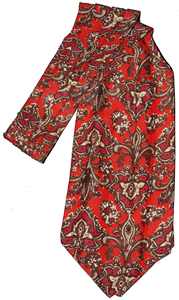
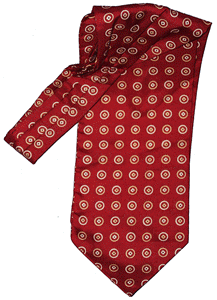
The vintage cravat is one of my favourite items of vintage clothing. It is a wide piece of cloth tied around the neck like a scarf, and then tucked into an open neck shirt. It is to be distinguished from the current wedding fashion of a ready-made cravat fastened at the back of the neck, which is also called an Ascot.
The casual cravat can be worn with jeans and a pullover, as well as more formally with a jacket and trousers, but never with a suit. It is a perfect way to give a bit of extra warmth around the neck in the winter months.
Sadly it is almost extinct now in mainstream fashion; being seen as too formal for casual wear and too casual for formal wear.
The word cravat dates from the seventeenth century and comes from the word Croat. Croat soldiers served with the French army in the seventeenth century. In that time it was commonplace for officers to customise their uniforms. Officers of the French army saw that the Croats tied a long piece of muslin or lace around their necks and adopted this fashion themselves. The neckwear was called 'la Cravate'. Cravate is still the current French word for tie and the cravate is the origin of the modern tie as well as the bow tie, hunting stock (fastened with a stick pin) and the formal cravat or Ascot.
Around the same time in England, Charles II brought the Persian fashion of wearing a long coat instead of a doublet to the English court. With the Persian style coat the wide white lacy collars seen on Civil War era portraits were no longer comfortable. The cravate offered the ideal solution and it became de rigueur in England as well as France.
Somewhere along the way in the English language the word 'cravate' lost its 'e'. The cravat became fashionable menswear for many years and was a favourite of the regency dandy, Beau Brummell, who reputedly spent whole mornings with his valet perfecting the knot.
The origins of the informal or casual cravat are in the first part of the twentieth century. Rather than being worn outside the shirt, it was tucked into an open necked shirt. This style gained popularity with the 'bright young things' of the 1920s and 30s. The Prince of Wales (later Edward VIII) was a leader of men's fashion and a firm devotee of the casual cravat. He was often seen on the golf course wearing a cravat, along with plus fours.
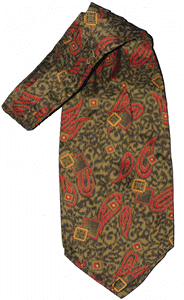
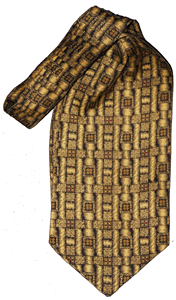
In 50s and 60s menswear the cravat was worn casually as it had been in the 30s. It survived into the 60s, although younger men were abandoning the cravat, preferring an open necked shirt for a more casual look.
Fashion designer Hardy Amies was not a great lover of the cravat. He preferred to call it a choker and reserve the word 'cravat' for the older style tie similar to the hunting stock. He felt a cravat could ruin an outfit if carelessly chosen and writing in 1964, thought it had been abandoned by the young.
This was not quite true as the cravat enjoyed a brief spell of popularity with the Mod movement in the sixties and was brought to life again in the 1979 Mod revival.
On the small screen the cravat was worn by Bob Ferris (Rodney Bewes) in 'Whatever Happened to the Likely Lads'. Bob wore his cravat outside the shirt, a foppish fashion that could only really suit the early seventies. Another way of wearing the cravat from the late 60s and early 70s era was to fasten it with metal clip or ring, rather than tying it.
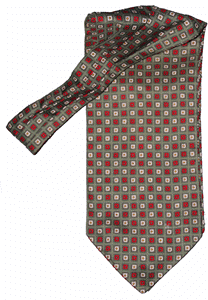
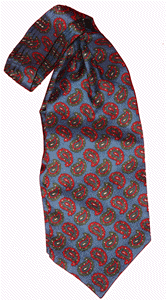
However, by the mid seventies the cravat had become an old man's fashion. It was worn by the blazer sporting pub bore depicted by Eric Idle in Monty Python's 'nudge nudge' sketch and suffered the final blow in the hands of another Python, John Cleese as clueless hotelier, Basil Fawlty (1975).
Recently the cravat has returned to Mod fashion and you can buy them on Carnaby Street in London. However, there also are plenty of vintage examples still available.
Collectors' information
The principal manufacturer of ties and cravats in the 50s, 60s and 70s was Tootal. Tootal polyester cravats were very popular in the 50s and 60s.For the ultimate luxury though, only silk will do. Harrods made upmarket silk cravats. Other manufacturers included Luvisca, a maker of shirts in the first half of the twentieth century.
Look for strong paisley patterns of psychedelic swirls. Expect to pay from £5 to £25. Attractive or unusual patterns increase value. Condition is of critical importance. Look for excellent, undamaged examples. Avoid heavily worn cravats.
Identification
How do you know that you are looking at a vintage cravat and not just a second-hand one? Patterns did not change greatly, but look for paisleys or psychedelic ones to help identify a cravat from the 60s or 70s.
Labels help enormously. I usually look for the absence of the now familiar wash care symbols. These came into use in the mid seventies and if the garment does not have these, it is unlikely to be made after 1980. Generally, the fewer wash care instructions, the older the garment.

1950s Luvisca

1960s Harrods

Early 1960s Tootal

Late 1960s Tootal

Grosvenor by Tootal, 1970s
These are a few vintage labels that will help you to identify a genuine vintage cravat. Tootal is the most common brand and 'Grosvenor by Tootal' is a label that appeared in the 70s.
The description of the material can also help date the cravat. Trade names of man-made fibres such as as Rayon, Trivera or Terylene are likely to appear on 50s or 60s ties and cravats that were not made of silk. Sometimes 'made from 100% polyester fibre' is also added to a trade name for the man-made material, sometimes just 'acetate'. Those from the 70s or later are more likely to be labelled just '100% polyester'.
By Steven Braggs,January 2012


Comments
I have a cravat lable says "favourite" made in england I cant find any reference to this makerror don't suppose you can tell me anything